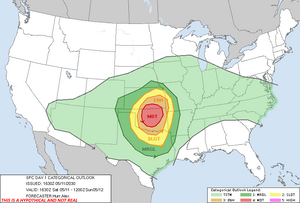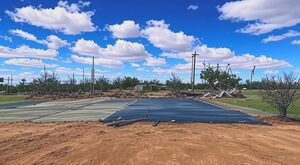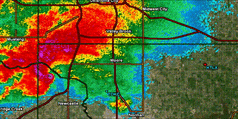2030 Moore tornado: Difference between revisions
No edit summary |
No edit summary |
||
| Line 23: | Line 23: | ||
== Meteorological synopsis == | == Meteorological synopsis == | ||
[[File:May112030SPCOutlook.png|thumb|left|1630 UTC Day 1 outlook on May 11.]] | [[File:May112030SPCOutlook.png|thumb|left|1630 UTC Day 1 outlook on May 11.]] | ||
On May 11, 2030, an intense upper-level trough | On May 11, 2030, an intense mid- to upper-level trough emerged into the Southern Plains from the Desert Southwest, providing deep-layer ascent across Oklahoma and northern Texas. A strong 500 mb jet max of 90–100 knots overspread the region, resulting in significant upper-level divergence. At the surface, a rapidly deepening low-pressure system centered near the eastern Texas Panhandle helped draw a warm front northward across central Oklahoma. This frontal boundary intersected a sharpening dryline stretching from southwestern Oklahoma into western Kansas, forming a textbook triple point scenario. | ||
The environment featured extreme instability, with surface temperatures reaching 86 °F and dewpoints around 73 °F. Surface-based CAPE exceeded 4450 J/kg, while 0–3 km lapse rates reached 8.7 C/km and 3–6 km lapse rates neared 7.4 C/km, indicating a deep, unstable profile conducive to strong updraft acceleration. Storm-relative helicity values were measured at 457 m²/s², supportive of intense low-level rotation. Although PWAT values were modest at 0.4 inches, the environment remained primed for tornadic supercells due to dry air aloft and strong vertical wind shear. A robust low-level jet also contributed to strong moisture transport and storm-relative inflow. | |||
The Storm Prediction Center issued a Moderate Risk for severe weather | The Storm Prediction Center issued a Moderate Risk for severe weather with a focused threat for strong to violent tornadoes. A Particularly Dangerous Situation (PDS) tornado watch was issued by early afternoon. Environmental soundings taken from central Oklahoma showed a large, curved hodograph, indicating strong directional shear and long hodograph loops ideal for cyclic tornadogenesis. By early afternoon, discrete supercells began forming in the triple point region, with one storm rapidly intensifying southwest of Moore and producing the tornado that would become the day's most destructive. | ||
== Tornado == | == Tornado == | ||
The 2030 Moore tornado first touched down at 1:21 p.m. CDT near the rural outskirts of Newcastle, Oklahoma. | The 2030 Moore tornado first touched down at 1:21 p.m. CDT near the rural outskirts of Newcastle, Oklahoma. Initially producing EF0 to EF1 damage, the tornado rapidly intensified as it tracked northeast. Upon entering Moore city limits, the tornado grew significantly in size and strength, with radar confirming a tight velocity couplet and a well-defined debris ball. It was over south-central Moore that the tornado underwent a marked intensification phase, quickly expanding to approximately 1 mile wide. This strengthening coincided with its transition from EF2 into EF4 intensity. | ||
As the tornado moved through residential subdivisions in southern Moore, EF4 damage became widespread. Numerous homes were completely destroyed, and vehicles were lofted and mangled. The tornado passed directly over Plaza Towers Elementary School, which had been tragically hit in 2013, but this time no children were present as the event occurred on a Saturday. The most extreme damage occurred shortly thereafter, in southern Moore, where a well-engineered and anchor-bolted restaurant was obliterated—this was the sole location used to justify the EF5 rating. The National Weather Service assigned the site an estimated wind speed of 205 mph. | |||
The tornado maintained violent intensity as it crossed Interstate 35 and moved through densely populated neighborhoods, flattening homes and businesses. It continued into eastern Moore before beginning to weaken, eventually dissipating at 2:07 p.m. CDT west of Lake Stanley Draper. In total, the tornado was on the ground for 46 minutes and traveled a distance of 15.1 miles. | |||
== Impact == | == Impact == | ||
| Line 41: | Line 41: | ||
The tornado's impact on Moore was nothing short of devastating. Over 2,000 homes and businesses were damaged or destroyed across a swath of residential neighborhoods, shopping centers, schools, and critical infrastructure. Streets were rendered impassable due to massive debris fields. Entire subdivisions were reduced to rubble, and widespread power outages blanketed much of Cleveland and Oklahoma counties. Communications systems were temporarily knocked offline in some areas. | The tornado's impact on Moore was nothing short of devastating. Over 2,000 homes and businesses were damaged or destroyed across a swath of residential neighborhoods, shopping centers, schools, and critical infrastructure. Streets were rendered impassable due to massive debris fields. Entire subdivisions were reduced to rubble, and widespread power outages blanketed much of Cleveland and Oklahoma counties. Communications systems were temporarily knocked offline in some areas. | ||
The tornado claimed at least 35 lives and injured more than 315 people. | The tornado claimed at least 35 lives and injured more than 315 people. However, it took several weeks to finalize the death toll due to the immense destruction and the prolonged effort to locate those reported missing. Search and rescue operations continued for days after the storm, as responders worked around the clock in hazardous conditions to clear debris and access collapsed structures. Several victims were found in storm shelters that had been compromised or buried under debris piles. | ||
In addition to the destruction of homes, two schools were either destroyed or sustained heavy damage. The Orr Family Farm, a well-known local landmark, was flattened along with adjacent equestrian facilities. Emergency responders, aided by volunteers and search dogs, worked through the night in dangerous conditions to search for survivors. Many residents credited timely warnings from local broadcasters and weather radios for saving lives, though the intensity and speed of the tornado still left little time to act. | In addition to the destruction of homes, two schools were either destroyed or sustained heavy damage. The Orr Family Farm, a well-known local landmark, was flattened along with adjacent equestrian facilities. Plaza Towers Elementary School, which had been rebuilt after the 2013 tornado, once again found itself in the tornado’s direct path. Fortunately, the storm struck on a Saturday, and the school was unoccupied at the time. Emergency responders, aided by volunteers and search dogs, worked through the night in dangerous conditions to search for survivors. Many residents credited timely warnings from local broadcasters and weather radios for saving lives, though the intensity and speed of the tornado still left little time to act. | ||
== Aftermath == | == Aftermath == | ||
Revision as of 07:59, 30 ⧼april⧽ 2025
Bottom: Radar loop of the tornado as it went through Moore. | |
| Meteorological history | |
|---|---|
| Formed | May 11, 2030, 1:21 p.m. CDT (UTC-5:00) |
| Dissipated | May 11, 2030, 2:07 p.m. CDT (UTC-5:00) |
| Duration | 46 minutes |
| EF5 tornado | |
| on the Enhanced Fujita scale | |
| Path length | 15.1 miles (24.3 km) |
| Highest winds | 205 mph (330 km/h) |
| Overall effects | |
| Fatalities | 35+ |
| Injuries | 315+ |
| Damage | ~$2.1 billion (2030 USD) |
| Areas affected | Cleveland and Oklahoma Counties in Oklahoma, mainly the city of Moore |
|
| |
| Part of the Tornado outbreak of May 11-12, 2030 and the Tornadoes of 2030 | |
The 2030 Moore tornado was a catastrophic and violent EF5 tornado that struck the city of Moore, Oklahoma on May 11, 2030. As part of a larger tornado outbreak affecting the Southern Plains, this tornado caused widespread devastation across Cleveland and Oklahoma counties, leaving a trail of destruction reminiscent of the deadly tornadoes that struck the region in 1999 and 2013. The tornado reached a peak intensity of EF5 on the Enhanced Fujita scale, with estimated winds of 205 mph (330 km/h), and carved a destructive path through densely populated areas, making it one of the most intense tornadoes to impact the United States in recent history.
This was the third EF5 tornado to strike the city of Moore, following the devastating events of May 3, 1999, and May 20, 2013. It also marked the third EF5 tornado to occur in the United States since 2013, breaking a nearly two-decade lull in top-rated tornadoes. Despite the widespread damage throughout the city, the National Weather Service assigned the EF5 rating based on a single damage indicator: the complete destruction of a well-constructed restaurant in southern Moore. The rest of the tornado’s damage, while extreme and consistent with EF4 intensity, did not meet the required damage indicators for an EF5 rating. However, the destruction of the restaurant, which had been bolted to its foundation and engineered to high standards, supported winds well over 200 mph.
Meteorological synopsis

On May 11, 2030, an intense mid- to upper-level trough emerged into the Southern Plains from the Desert Southwest, providing deep-layer ascent across Oklahoma and northern Texas. A strong 500 mb jet max of 90–100 knots overspread the region, resulting in significant upper-level divergence. At the surface, a rapidly deepening low-pressure system centered near the eastern Texas Panhandle helped draw a warm front northward across central Oklahoma. This frontal boundary intersected a sharpening dryline stretching from southwestern Oklahoma into western Kansas, forming a textbook triple point scenario.
The environment featured extreme instability, with surface temperatures reaching 86 °F and dewpoints around 73 °F. Surface-based CAPE exceeded 4450 J/kg, while 0–3 km lapse rates reached 8.7 C/km and 3–6 km lapse rates neared 7.4 C/km, indicating a deep, unstable profile conducive to strong updraft acceleration. Storm-relative helicity values were measured at 457 m²/s², supportive of intense low-level rotation. Although PWAT values were modest at 0.4 inches, the environment remained primed for tornadic supercells due to dry air aloft and strong vertical wind shear. A robust low-level jet also contributed to strong moisture transport and storm-relative inflow.
The Storm Prediction Center issued a Moderate Risk for severe weather with a focused threat for strong to violent tornadoes. A Particularly Dangerous Situation (PDS) tornado watch was issued by early afternoon. Environmental soundings taken from central Oklahoma showed a large, curved hodograph, indicating strong directional shear and long hodograph loops ideal for cyclic tornadogenesis. By early afternoon, discrete supercells began forming in the triple point region, with one storm rapidly intensifying southwest of Moore and producing the tornado that would become the day's most destructive.
Tornado
The 2030 Moore tornado first touched down at 1:21 p.m. CDT near the rural outskirts of Newcastle, Oklahoma. Initially producing EF0 to EF1 damage, the tornado rapidly intensified as it tracked northeast. Upon entering Moore city limits, the tornado grew significantly in size and strength, with radar confirming a tight velocity couplet and a well-defined debris ball. It was over south-central Moore that the tornado underwent a marked intensification phase, quickly expanding to approximately 1 mile wide. This strengthening coincided with its transition from EF2 into EF4 intensity.
As the tornado moved through residential subdivisions in southern Moore, EF4 damage became widespread. Numerous homes were completely destroyed, and vehicles were lofted and mangled. The tornado passed directly over Plaza Towers Elementary School, which had been tragically hit in 2013, but this time no children were present as the event occurred on a Saturday. The most extreme damage occurred shortly thereafter, in southern Moore, where a well-engineered and anchor-bolted restaurant was obliterated—this was the sole location used to justify the EF5 rating. The National Weather Service assigned the site an estimated wind speed of 205 mph.
The tornado maintained violent intensity as it crossed Interstate 35 and moved through densely populated neighborhoods, flattening homes and businesses. It continued into eastern Moore before beginning to weaken, eventually dissipating at 2:07 p.m. CDT west of Lake Stanley Draper. In total, the tornado was on the ground for 46 minutes and traveled a distance of 15.1 miles.
Impact

The tornado's impact on Moore was nothing short of devastating. Over 2,000 homes and businesses were damaged or destroyed across a swath of residential neighborhoods, shopping centers, schools, and critical infrastructure. Streets were rendered impassable due to massive debris fields. Entire subdivisions were reduced to rubble, and widespread power outages blanketed much of Cleveland and Oklahoma counties. Communications systems were temporarily knocked offline in some areas.
The tornado claimed at least 35 lives and injured more than 315 people. However, it took several weeks to finalize the death toll due to the immense destruction and the prolonged effort to locate those reported missing. Search and rescue operations continued for days after the storm, as responders worked around the clock in hazardous conditions to clear debris and access collapsed structures. Several victims were found in storm shelters that had been compromised or buried under debris piles.
In addition to the destruction of homes, two schools were either destroyed or sustained heavy damage. The Orr Family Farm, a well-known local landmark, was flattened along with adjacent equestrian facilities. Plaza Towers Elementary School, which had been rebuilt after the 2013 tornado, once again found itself in the tornado’s direct path. Fortunately, the storm struck on a Saturday, and the school was unoccupied at the time. Emergency responders, aided by volunteers and search dogs, worked through the night in dangerous conditions to search for survivors. Many residents credited timely warnings from local broadcasters and weather radios for saving lives, though the intensity and speed of the tornado still left little time to act.
Aftermath
Following the disaster, a federal emergency was declared, and extensive resources were mobilized. The Oklahoma National Guard established perimeter security and assisted with search and rescue, while FEMA coordinated the deployment of urban search teams, temporary housing units, and debris clearance. More than 30 shelters were opened across the metro, many housed in church gyms and school auditoriums.
The tornado reignited national discussions about storm safety and construction standards. Moore, having already adopted stricter building codes after 2013, now faced questions about whether even those improved standards were sufficient. Engineers began studying the destroyed restaurant and other structural failures to inform future building designs in tornado-prone areas.
Volunteers poured in from around the country. Charitable organizations coordinated donations, food drives, and trauma counseling. Within weeks, city leaders began to outline long-term rebuilding plans, which emphasized storm shelter installations, enhanced community alert systems, and infrastructure reinforcement. The tragedy also prompted emergency management offices nationwide to revisit public outreach strategies for severe weather preparedness.
See also
Tornado outbreak of May 11-12, 2030
1999 Bridge Creek–Moore tornado
Part of
The 2030 Moore tornado was the most destructive tornado in a two-day outbreak that produced 19 confirmed tornadoes across Oklahoma, Kansas, and Missouri. Alongside the Moore tornado, the outbreak included the 2030 El Reno EF4 tornado and several EF2–EF3 events. The moderate-risk forecast verified with multiple cyclic supercells and high-end thermodynamic profiles contributing to violent tornado development across the Southern Plains. The outbreak reaffirmed central Oklahoma’s unfortunate status as one of the most tornado-prone regions in the world.

